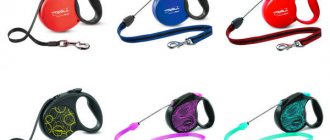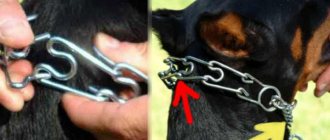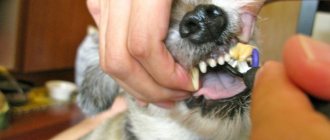Pets are mobile and active. By walking them on the street, the owner runs the risk of not being able to keep his pet and losing it. The right solution would be to put a harness on the dog. This accessory helps to securely secure the shoulders and chest without injuring or causing pain to the dog. The only difficulty that causes a lot of trouble is the process of getting used to the new harness, which is strange and unusual for the animal.
- 1 At what age should a dog wear a harness?
- 2 Mr. Tail recommends: step-by-step instructions (how to put a harness on a dog)
- 3 What is a harness
- 4 Harness or collar
- 5 Types of harnesses 5.1 By material
- 5.2 By purpose
How to accustom a puppy to a collar
One of the first questions that owners ask after purchasing a pet is “How to accustom a puppy to a collar?” If we are talking about a very small puppy, then this will not be difficult to do, but if you purchased or adopted from a shelter an almost adult dog that sees such equipment for the first time, you will have to tinker. One way or another, let's look in detail at what age to accustom a puppy to a collar and how to do it correctly.
When can you put a collar on a puppy?
Most breeders place collars on puppies as early as one week of age. This is done because it is convenient to put an individual mark on the collar, which will allow the kids not to be confused with each other. Typically, breeders make the first collars themselves, using braid or suede, and sew on a button to secure them. Store-bought collars with buckles are not suitable for very small puppies. The fact is that puppies will fiddle with, chew and pull the free ends of the collar of their brothers, the buckle often unfastens, the collar turns into a loop and the puppy can simply be strangled. In general, it is unacceptable for the collar to put pressure on the neck; it should be quite loose. For adult dogs, it is considered normal for two fingers to fit freely under the collar.
Usually a puppy is taken home from the breeder at 2-3 months. At this age, it is already acceptable to wear a collar with a buckle, so as soon as the pet gets comfortable in its new home, you can purchase a collar that fits the size and begin training it. As for when to put a collar on a puppy who is more than six months old, the answer is the same - as soon as the dog gets at least a little accustomed to the new place.
How to convince your puppy that everything you do is completely safe
The owner will constantly have to perform such an action as taking the dog by the collar in order to take it home. The fact that a person approaches the puppy and also extends his hand, many dogs perceive as an invasion of their personal space. Because of this, the dog may attempt to run away or express its aggression. Try to reassure the puppy that your actions do not pose a threat to him. In order to keep the dog calm and also to develop its reaction to touch, you can give treats. Taming must take several stages.
Prepare a treat for your dog, sit next to him, on the side, and very slowly extend your hand towards the collar. Offer your dog treats and release the collar. You need to repeat these steps with different hands. Make sure that the puppy looks at the owner's face, and does not look at his hands. This exercise should be done every day, several times, and the collar should be grasped from different sides. All actions should be reinforced with treats.
Only patience, as well as a very affectionate relationship, will help regulate the dog’s behavior. If you handle it roughly, the effect will be the opposite; as a result, the owner will have to deal with the correction of the animal’s psyche. If a dog has just appeared in your home, or you are planning to purchase one, contact the specialists of the veterinary clinic, they will provide answers to the most important questions.
When to wear a collar
For service dogs, the collar is practically part of the body; they wear it constantly. For hunters, on the contrary, it is unnecessary - during a hunt, the collar can get caught on a branch, and then you will be exhausted looking for the stuck dog. As for ordinary pets, they need it primarily so that they have something to attach the leash to. Also, an address tag with the dog’s name and the owner’s contact information is often hung on the collar , so that if the dog is lost, the dog can always be returned home.
No matter how obedient your pet is, do not take him for a walk without the appropriate equipment. Walking your dog in the city without a collar or harness is extremely risky!
What is a harness
A device for animals that replaces a collar, used for walking and equipped with an attachment for a leash, is called a harness. Initially, this accessory was developed for small breed dogs that could easily wriggle out of the collar. Later, breeders considered the additional positive aspects of the device and began to purchase it for animals of any size.
Leather or fabric belts cover the pet in the chest area and along the body immediately behind the front legs; a jumper runs along the lower part of the chest, connecting the ring elements. There is a metal connecting block in the withers area. It connects all the harness straps and is where the leash carabiner is attached.
It is important that the pet’s neck remains open, that is, the danger that the pet will get caught on objects protruding from the ground and block its breathing with a jerk or injure the spine is excluded.
The harness is securely fixed and even very fidgety dogs will not be able to escape from it, escaping the owner’s control.
The accessory is also widely used for service dogs that are involved in rescue operations.
During training, breeders often attach weights and other devices to the harness to help develop the animal’s physical abilities.
At what age should a puppy be accustomed to a collar and leash?
Experts recommend introducing your pet to new objects for the first time at the age of one and a half months. Most likely, an unfamiliar thing on the neck will irritate the puppy at first, but the main thing is to show a little patience, do not punish, do not behave aggressively, and the efforts will be rewarded.
The training process, as a rule, begins at the age of three months, at which time you can accustom the baby to the toilet, his own place. However, it is impossible to go outside with a puppy without a collar and leash, which is why already at one and a half months they put a collar on the pet for the first time. The process of a baby’s adaptation to new objects is divided into several stages to make the task easier and not to traumatize the puppy’s psyche.
If your puppy has not yet been vaccinated or is not fully vaccinated, you can and should still walk him.
The best electric collars for dogs Anti-bark
This type of electric collar is designed to “educate” dogs so that they stop barking loudly for no reason, which is why they are called “Anti-barking.” The choice of such models is quite large, but only two models can safely be called the best options. They were included in this category due to their safety, ease of use and effectiveness of use.
PET853
... Testing of the PET853 electric collar showed that it is easy to operate due to a specially designed microprocessor. This model worked great on the Chihuahua breed, but is also suitable for larger breeds, up to a weight of 60 kg...
Expert opinion
This device was created to wean a dog from whining, barking, and howling, including in the house in the absence of the owners. The electric collar has a gentle effect on the dog and is safe for health thanks to its flexible settings. Here you can adjust the sensitivity, selecting its most optimal degree.
The manufacturer thought of everything ahead and protected the animal from excessive stimulation using an automatic mechanism. It uses a unique technology that minimizes the likelihood of false positives. Setting up an electric collar for dogs is very simple, using the “+” / “-” switches.
Advantages:
- Durable control panel housing;
- Test light included;
- Gradual increase in the strength of the current;
- Effective dog control algorithm;
- Blocking the effect for 1 minute if the pet does not react.
Flaws:
The warranty is only for 3 months.
Anti-bark PD-258S
This budget model is designed for use to control barking in small and medium breed dogs weighing from 2 kg. It works on the same principle as the previous device in the rating, but has a more compact size. With its help, it is possible to calm the animal due to the activation of the microphone built into the sensor, which responds to sound vibrations. As a result, the electric collar emits a fairly loud signal. If the dog does not stop barking, then its volume increases, and for the third time a discharge is added to this. Despite the noise level, it is safe for the animal and does not rise above permissible limits.
Advantages:
- Fast action;
- High efficiency;
- Does not cause noticeable discomfort;
- Nice price;
- Electrodes for different types of wool;
- Easy;
- Fits firmly on the neck.
Flaws:
Not detected.
The electric collar for dogs “Anti-bark PD-258S” is interesting because it reacts not only to barking, but also to whining and howling.
Choosing a Collar
The choice of collar is of great importance. Keep in mind that the dog will grow, and for the first lessons there is no need to choose expensive, special equipment. The most comfortable will be a flat and lightweight collar that will not cause discomfort.
Avoid chain-shaped collars; a small puppy will most likely not want to wear one, because hair fibers getting into the chain links cause considerable discomfort.
Stages of training
The sooner you start training your puppy, the easier it will be for you in the future.
It is not surprising that a pet's first acquaintance with new things causes protest, but this is a completely predictable reaction. To make the dog’s habituation process as easy as possible, experts recommend breaking it down into several stages.
Adaptation
It is necessary to remember that the issue will not be resolved in one day; regular practice will be required when the dog is calm or playing. A reward system should be introduced from day one. There are several reward options for a pet, each owner can choose the one that the puppy likes.
How to reward a puppy:
- Every time your puppy diligently follows your instructions, give him a treat.
- Surely the puppy has a favorite game, after the lesson with the collar - play with the pet.
- Clicker rewards are used to communicate with a dog without physical contact, in which case the owner praises the puppy through a beep.
Now the puppy should gradually get used to the collar. If your pet is nervous and tries to take off his new clothes, don’t worry, try to calm the dog down.
How to calm a puppy:
- Distract your pet with play.
- Reward your puppy every time he agrees to wear the collar.
- Check whether the puppy is comfortable in the collar; it should fit snugly to the neck, but not restrict movement.
A puppy can be at home wearing a collar only if someone is looking after him; if you leave and leave the pet alone, the collar must be removed.
Each puppy's attitude towards a leash is individual - some categorically do not want to be deprived of freedom of movement, while others do not even notice the new object. In any case, the first time you attach the leash to the collar, throw the free edge and let the puppy run around and understand that the new object is not dangerous. During the first days, be sure to make sure that the leash does not entangle the puppy while playing and running. Give your dog a treat each time you remove the leash.
Leash training outdoors
As soon as the puppy begins to walk calmly in his harness at home, on average it will take four days, try going outside with your pet. What nuances should you consider when going for a walk for the first time with a collar?
KEEP CALM
Very often, dogs that calmly respond to a leash at home, on the street begin to behave completely differently - they whine, bark, do not want to walk, but simply lie down on the ground. The owner’s task is to remain calm, not scold the dog, and not use violence. Remember that many dogs behave like their owners; if the person is calm, most likely the puppy will follow his example.
REMEMBER ABOUT REWARDING
When going outside, take a treat with you, try to calm the puppy down with a treat, or distract the puppy with a game. Pieces of sausage or cheese are suitable as a treat.
BE CONSISTENT
React adequately to every action of the puppy - if the dog obeyed you, pet it and reward it, and punish it for misdeeds and bad behavior. There are certain methods of dealing with bad habits; they are effective, but only on condition that they enter the system and are used constantly.
Rules for using the planer
The first rule of using a planer is that it should not be worn for a long time. Only during training and if there is a need to correct the dog’s incorrect behavior during a walk. Increase the jerk force as needed.
If your pet behaves well during training, this is the first signal that you need to get rid of the bully. Look for your “golden rule” of application, feel your student.
The dog should not get used to following commands only in parforce. And the dog should not, in principle, get used to the discomfort of the collar, otherwise the entire educational effect will come to naught. The most correct end result of training will be that the dog clearly follows commands not just without a handler, or in a gentle/regular collar, but also without a collar at all.
It will be useful for you to know how to cure a dog from: fleas, lice eaters, ticks (ear and subcutaneous), ringworm, worms and dandruff.
How to put a collar on a dog
An incorrectly worn collar will give two possible end results: lack of proper educational effect or injury to the animal.
A properly dressed parfors is located strictly under the ears, runs parallel to the jaw line and fits snugly to the neck. Incorrect - hanging loosely around the neck.
Video: how to properly put on a strict collar for a dog. Basically, strict collars come in the following types:
- in the form of a single chain with spikes, without detachable parts;
- a set of plates with spikes;
- a chain covered with fabric or leather on top.
In practice, the chain has proven itself best. It is convenient to attach a leash carabiner to it and, if necessary, you can adjust the length by opening and removing a couple of links.
The leash is located to the left of the neck by first attaching it to the “dead ring”, and later, when the animal is more adapted to wearing it, to the second “free ring”.
All European models have a split-link design, but there are also those that are put on over the head (although many experts consider this a big mistake). In any case, when choosing a model, individual fitting and fitting is important.
Important! It is absolutely wrong to put the planer over your head and then move it along your neck!
How to train a dog with a collar: basic rules
An example of training using a planer. You go with your pet to a place for walking or training. The dog is trying to pick up some object from the ground. Without raising your tone, you give a clear and strict command “fu” and jerk the leash.
Don’t be afraid to injure the animal - if the parforce is fitted correctly, it is safe. If the animal reaches out to pick up something again, you make an even stronger jerk and repeat the command just as strictly. The procedure is repeated until the dog begins to respond to the command without jerking.
As soon as this happens, you can try to give up the planer a little at a time. For example, go to the site wearing a regular leather strap.
The use of parfors in everyday life may be in exceptional cases. For example, guests come to you, and the dog reacts aggressively to them. But at home and during normal walks it is advisable not to use it.
Did you know? Already in ancient times, collars had not only functional, but also decorative significance. The wall paintings contain images of four-legged hunters, on whose long necks the shine of precious stones, mounted either on metal or on perfectly dressed calfskin, is recreated in subtle shades of paint.
How to remove the collar
The design of the parfors assumes that removal will be by disconnecting the link or unfastening the carabiner from the chain. To do this, you need to squeeze the chain link with your thumb and forefinger and pull out this link with an upward movement.
It's always easier to unfasten a collar than to put it back on correctly and quickly, so if you're just giving your dog a break, it makes sense to unfasten the leash's snap hook. It’s even better to consult with experienced trainers.
Possible problems
The puppy constantly pulls on the leash
Every time the pet resists and does not want to go in the indicated direction and begins to pull on the leash, stop, but do not pull the dog. Let the pet understand that any attempts to go in the opposite direction from the owner end in nothing. Call your baby over and give him a treat; if you use this pattern constantly, the dog will soon wean itself off the habit of pulling on the leash.
Types of harnesses
Harness is divided into types according to the type of materials and purpose. In addition, there are harnesses of various sizes, colors and shapes. Some manufacturers create accessories based on breed.
By material
Harnesses are made from different materials; they significantly affect the quality and comfort of the pet, so it is necessary to study the properties of the accessory and the needs of the animal before purchasing.
Synthetic
They are distinguished by the greatest practicality, reliable, durable, waterproof. Easy to wash. They are inexpensive and last a long time.
Canvas
Particularly durable and practical. They are difficult to wash and darken over time. Relevant for large breed dogs.
Leather
The stylish appearance does not last long. This is more of a decoration than an everyday walking accessory. The material does not tolerate temperature changes well, quickly cracks and wears out. Expensive goods.
By purpose
In addition to the material of production, harnesses are divided according to their purpose:
| Name | Function |
| With loads | A training accessory used for the rehabilitation of animals after injuries, as well as for the preparation of sledding and fighting breeds. |
| Riding | Used for competitions or travel in the Far North. They are distinguished by the highest strength and a design that allows you to pull loads with minimal stress. |
| Vest | Designed for short-haired breeds that require insulation. It has additional fastening in the area of the hind limbs, therefore it is widely used for therapeutic purposes for animals with joint diseases. |
| Walking | They are more comfortable for dogs, but not very durable. |
| Guardhouse | Designed for guard dogs that spend a lot of time on a chain. An additional margin of safety is provided. |
| For puppies | Strictly not suitable for animals under the permissible age (6-7 months minimum). It is an intermediate accessory that allows you to gently prepare the dog for a more serious harness. Light version. |
How to properly put a collar and leash on a dog
How quickly the pet will get used to the new thing depends on how well the collar is put on the dog for the first time.
To begin, simply place the collar in front of the puppy and wait a few minutes, during which time the pet will get acquainted with the new thing and make sure it is safe. Be careful that the puppy does not start playing with the collar, otherwise in the future he will continue to treat the equipment as a toy. If the dog is actively chewing on the new thing, take the collar and stop trying to put it on the puppy’s neck for a while. After about ten minutes, when the dog stops showing interest in the thing, try again.
Stock up on treats, call the puppy, give him something tasty and show him the collar. Just before attempting to put on the harness, reward your dog with a treat again. You need to handle the puppy with extreme caution; any careless movement will scare him away, and then you won’t be able to try again for a long time. For the first time, it is advisable to try to put on the collar without touching the puppy with your hands. If your pet agrees to try on the equipment, be sure to treat him with a treat.
If the dog gets scared and runs away, use one of the following techniques:
- Use the collar as a mark, and when the puppy approaches it, he gets a treat.
- Take the collar in your hand, stroke the puppy with it and feed it something tasty.
Such actions will help the dog quickly get used to the equipment and calmly tolerate the touch of the collar. As soon as you feel that your pet is not afraid of the object, try putting it on and immediately taking it off.
At the same time, allow the puppy to go to a safe place and do not disturb him for a while.
The next day, put the collar on for a few seconds, following a similar pattern - don’t skimp on treats, show maximum calm and no aggression. After another day, try putting the collar on the dog and playing with it for a while; if the puppy does not try to remove the equipment, leave the collar on the pet, and if there are signs of anxiety, distract it with play or a treat.
When the dog feels completely calm in the collar, do not take it off even at home, but only if there is someone in the room.
Be sure to consult whether a dog can be in a collar for a long time in a row; for example, dogs of hunting breeds must be freed from equipment while working in the field so as not to be injured.
Correct selection
To ensure that the harness does not harm your pet, it is necessary to choose it correctly. Major manufacturers of pet accessories have special tables that take into account dog sizes, weights and volumes. Some brands make adjustments based on breed.
To choose the right harness, you will need the following measurements:
- The dog's height is measured in a standing position from the withers to the floor.
- The length of the back is equal to the distance from the tail to the base of the neck.
- The chest is measured along the front surface from the right front paw to the left. The centimeter should not be too tight so that the harness does not restrict freedom of movement.
- The size of the neck is measured at the base, it is in this area that the top strap of the harness is located.
- The length from chest to withers is measured for sled dogs.
- Therapeutic harness is made individually, taking measurements and leaving 2 cm for freedom of fit. For small dogs, the allowance is smaller.
When purchasing a harness, it is checked for comfort. To do this, after putting the accessory on the dog, insert your palm under any of the belts. If the hand moves freely and the device does not dangle, then the size is chosen correctly.
The accessory is also used for cats; the method of habituation for them is similar to that described above using the example of dogs.
Common Mistakes
| Error | Consequences |
| Incorrect tightening of the collar. | If you put the collar on too loosely, the puppy will simply jump out of it. |
If you tighten it too tightly, there is a high risk of injuring your dog. In addition, the pet will perceive the collar as a source of unpleasant sensations.
| Roughness when putting on and taking off the collar. | This will lead to the fact that you will not be able to force your pet to put on the equipment and you will have to take measures to correct the dog’s behavior. |
| Sudden jerks while walking. | The dog will remember that the collar is painful and unpleasant. |
| Compulsion. | This will lead to the dog developing the wrong attitude towards the collar. |
| Permission to play with collar and leash. | The owner must show with every action that the equipment is a safe signal for a walk. |
Advantages and disadvantages of a harness
The undeniable advantage of a harness is that it is humane and does not cause any discomfort to the animal. But besides that:
- The harness helps correct problems with the dog’s musculoskeletal system and helps treat injuries.
- Indispensable during training or work - jerking the collar can distract the dog from its duties.
- You can make it yourself.
Cons of harnesses:
- If a collar can injure the larynx or block the respiratory tract, then an incorrectly worn harness can cause compression of the internal organs and cause severe rubbing, which leads to dermatological diseases.
- A harness can disrupt the normal development of muscles or interfere with their proper functioning. To avoid such situations, the equipment is selected according to the size of the dog and put on correctly.
- Not suitable for aggressive animals - a harness gives the dog freedom; it will not help to correct its behavior or stop unwanted aggression. Using only a harness without a collar on an aggressive dog can compound the problem.
- Price. The cost of harnesses, even those made from the most inexpensive materials, is always higher than for collars, and professional equipment can be very expensive.
The price of collars starts from 150 rubles (for small dogs), the upper limit is limited only by the owner’s imagination and wallet: the collar can be made to order and decorated with any materials - from rhinestones to precious stones, which determines the cost. The price of a harness immediately doubles: from 300 rubles for small dog breeds, and from 1000-1500 rubles for medium and large dogs. Although harnesses are also custom-made from different materials, they may differ in structure and fittings, so the upper limit of cost is also quite arbitrary.
Harnesses have many advantages over collars. In some cases, you cannot do without a harness. The final choice of mounting method, type or type depends solely on the wishes of the owner.
5 / 5 ( 1 voice )











